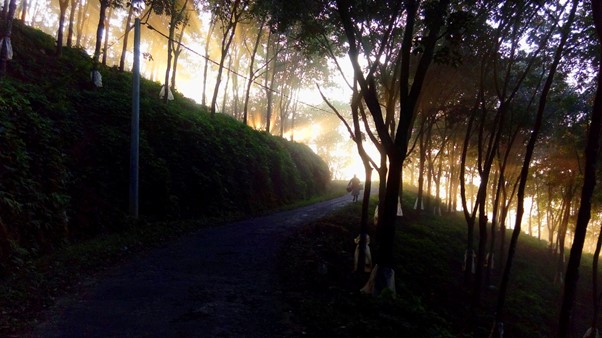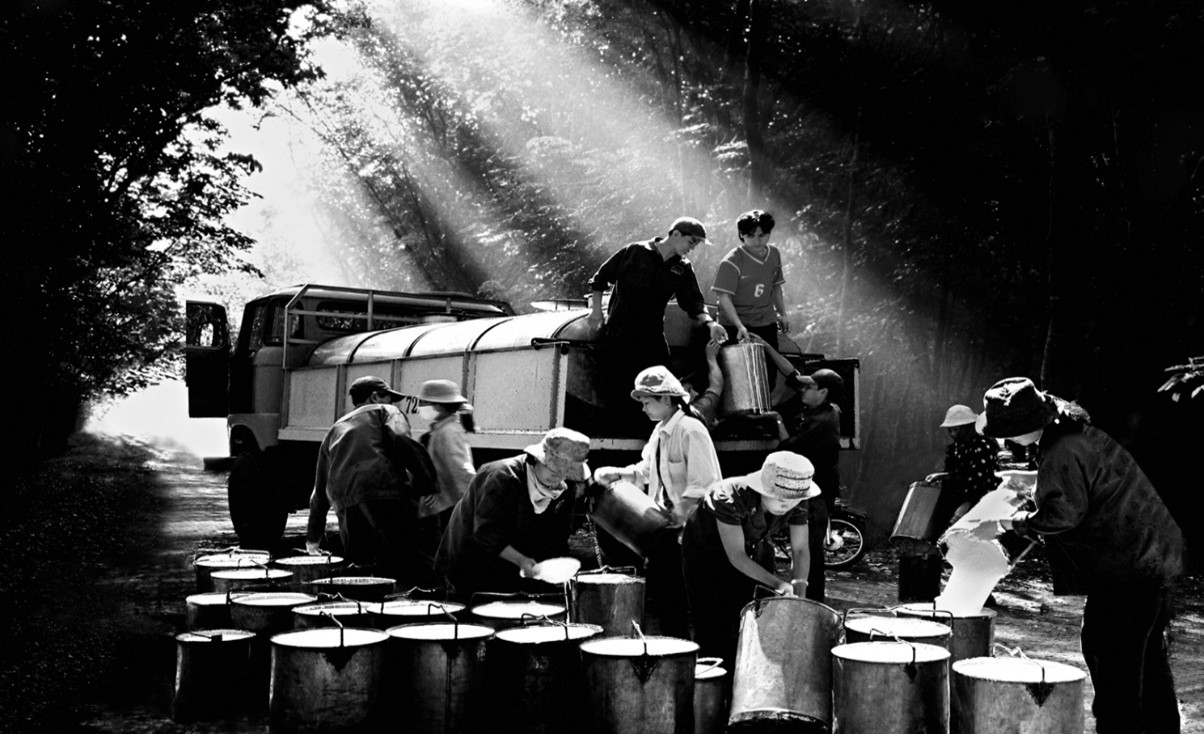
气候行动周特刊:
气候变化与橡胶经济
特刊中接受采访的专家有: Salvatore Pinizzotto (IRSG), Lekshmi Nair (IRSG), Vincent Gitz (CIFOR/FTA), Alexandre Meybeck (CIFOR/FTA), Datuk Dr Abdul Aziz b S A Kadir (IRRDB), James Jacob (IRRDB), Jerôme Sainte Beuve (CIRAD) and Eric Gohet (CIRAD)
How can natural rubber be part of the Climate Change actions?
天然橡胶如何能够参与到应对气候变化的行动中去?
The scientific consensus is clear: climate change is associated with increasingly frequent and intense natural disasters. The impacts of climate change are faster than ever predicted. The longer we wait to act on climate change, the greater the damage to countries and the global economy.
对于气候变化的科学共识是非常明确的:气候变化与越来越频繁、强烈的自然灾害有关。气候变化带来的影响比以往任何时期预计的都要快。我们越晚对全球气候变化采取行动,对各个国家和全球经济的破坏就越大。
What can we do to move from talk to action?
我们如何能从讨论转换到行动?
Natural rubber has a key role to play for both adaptation and mitigation of climate change as an important land user (≈14 Million ha), a producer of renewable materials (i.e. latex and rubberwood), and as a major economic activity.
天然橡胶作为一种重要的需要使用土地的农作物(全球种植面积约1,400万公顷)、可再生资源的生产者(例如乳胶和橡胶木)以及主要的经济作物,在适应和缓解气候变化方面都可以发挥关键的作用。

(Source: IRSG Photo Competition 2019, Early Morning, Ranga Alahakoon)
天然橡胶是一种生长在年平均气温介于26-28摄氏度之间地区、主要由中小农户种植的战略性工业原材料。目前天然橡胶已被广泛的应用于下游5000多种工业制品中,其中轮胎行业占据了举足轻重的位置。全球大约有4000万人参与到了天然橡胶的产业链中,每年全行业产值超过3000亿美元。天然橡胶的可持续生产和使用为行业的可持续发展提供了巨大的机会。
通过增强应对气候变化的能力,能使全球天然橡胶的生产能够得到保障,产量能够可持续的增加,同时也能够成功的为缓解气候变化做出贡献。自第二次工业革命以来,全球平均气温已经升高了1.1摄氏度。如果按照当前的全球变暖速度,这个数字将在二十年之内升至1.5摄氏度(IPCC报告,2018)。气候变化对天然橡胶来说意味着什么呢?要如何应对?我们又需要对天然橡胶的遗传资源,胶园管理方法和胶园的地点做哪些改变?我们认为,天然橡胶行业首当其冲需要的是相关的数据和信息。开始研究这些课题最好的方式,就是以可靠的数据和信息作依托,让科学成为讨论的基础和前提。
近日,国际橡胶研究组织(IRSG)连同国际林业研究中心(CIFOR)、农业研究发展促进中心(CIRAD)以及国际橡胶研究和发展委员会(IRRDB),共同主办了一次名为“气候变化与天然橡胶系统”的研讨会。在研讨会上,专家们探讨了有关气候变化对天然橡胶产业所产生影响的科学依据,潜在的应对方法,以及天然橡胶行业能对缓解气候变化所做的贡献。研讨会的主要目的在于了解已知情况、找出不足和未来能够研究和采取行动的领域。研讨会期间,专家们重点讨论了天胶遗传学以及管理和行业政策等一系列可以显著增强天胶对气候变化的适应性,从而帮助缓解全球气候变化的方法。专家们还讨论了天然橡胶在可持续发展和社区如何适应气候变化中能够起到的作用。专家们相信,这种形式的对话,在当前全球各国正在实施“国家自主贡献”(NDC)并准备其“国家适应计划”(NAP)的时刻,显得格外重要。
Visible Changes identified
辨别可见的改变
A steady rise in temperature and occurrence of extreme weather might compromise natural rubber production and supply chains in the different rubber growing countries. Among the responses to these risks, identified during the workshop, figure research on climate resilient clones, warning systems for pests and diseases, satellite mapping and ecophysiological modelling for identifying agro-climatically suitability of cultivation according to the various IPCC scenarios. Multifaceted challenges of climate changes call for greater cooperation among researchers across national borders. Exchange of information and a common research agenda can support all countries to make easy comparison on effect of weather events.
全球气温的持续上升和极端天气的发生可能会拖累天然橡胶的生产并且对各个天胶生产国的供应链造成负面的影响。在此次研讨会期间,专家们讨论了应对这些风险的相应措施,包括研究能够适应新气候的橡胶幼苗、病虫害预警机制、卫星测绘以及根据联合国政府间气候变化委员会提供的各类预测所展开的生态生理模型研究,从而更好的识别出天胶种植对于气候变化的适应性。全球气候变化带来的全方位挑战要求所有研究人员加强跨国界的合作。相互间的信息交流和共同的研究议程能够更好的支持各个国家比较气候变化带来的的影响。

(Source: IRSG Photo Competition 2019, Harvesting, Bui Thai Dung)
Facing climate risks, small farmers are particularly vulnerable. They need to be supported. At national and regional level, it is important to share appropriate climate information and projections that can help to predict distribution of rubber in traditional and marginal areas.
在面对来自全球气候变化的挑战时,广大中小胶农更容易受到影响,也更需要来自外界的支持。无论是在国家还是地区层面,将准确的气候信息和对气候变化的预测及时分享和传达给中小胶农,都能够对我们预测传统和新兴橡胶种植地带的胶林分布有巨大的帮助。
How can natural rubber contribute?
天然橡胶如何对缓解气候变化做出贡献?
There are different opportunities and knowledge gaps regarding the possible impacts of rubber (from plantations to end-products) on climate change adaptation and mitigation. Ecosystem-based adaptation has highlighted improvements in soil moisture, erosion, and soil chemistry. Rubber tree is a suitable component of agroforestry models for the purpose of enhancing tree cover for carbon sequestration. Carbon sequestration in plants and soils has additional benefit and bio-sequestration carbon offsets can have the potential to bring economic benefits to smallholders. Carbon sequestration process-based models can have the ability to describe C sequestration by rubber plantations (biomass and soil). Effects on soil erosion, soil degradation and runoff, can also be modelled at watershed level, depending on land management options and climate scenarios. There are opportunities for using genetically selected rubber germplasm for climate adaptation and rubber farming in degraded land for improving livelihood of farmers.
有关天然橡胶行业(从种植到制成品)会在适应和缓解气候变化的过程中受到什么影响这个课题上,当下存在不同程度的知识缺口和机遇。以生态系统为依托来适应气候变化能够显著地改善土壤水分、抗侵蚀性等土壤化学指标。天然橡胶胶树能够很好的成为农林业模式的组成部分,达到增强作物多样性和成为用于碳封存的树木覆盖层的功能。通过植物和土壤来进行碳封存具有其独特的优点,同时也能为中小农户带来经济利益。基于碳封存过程的模型可以用于解释天然橡胶胶林(生物质和土壤)如何参与到整个过程中去。对于土壤侵蚀,土壤退化和径流的影响,我们也可以根据土地管理模式和气候情景,在流域水平上进行建模。为了适应气候变化以及能够在退化的土地上种植天然橡胶,未来我们将有机会种植经过基因工程改造后的橡胶幼苗,从而改善胶农的生活质量。
Focus on Green Investments
专注绿色投资
Dealing with climate change, be it mitigation or adaptation, requires public and private investments. This means providing incentives for green investment and safety-net to pricing risk. Digital technology solutions can play an important role. The global GDP grew by 2.9% in 2019 according to the IMF, and if the global economy decarbonised at the same rate as in the last 10 years, that would still lead to an increase in global emissions. There is urgent need to address ecosystem- based adaptation plans for renewal of plantations, well aligned with the NDCs. Financial institutions are also able to play a key role in unlocking investments for a climate resilient rubber economy. There is an untapped potential to apply climate finance to the rubber sector to significantly reduce emissions and to encourage climate adaptation ensuring livelihood improvement for small farmers.
无论是缓解还是适应气候变化,我们都同时需要来自公共领域和私人领域的投资。这意味着需要为绿色投资提供政策上的激励措施和安全保障。数字技术解决方案可以在其中发挥重要作用。根据国际货币基金的数据,2019年全球GDP增长达到2.9%, 如果全球经济以与过去十年相同的速度脱碳,那么未来全球的碳排放量仍将继续增加。我们迫切地需要能与国家自主贡献(NDC)相匹配的、基于生态系统的气候适应计划和相应的替换种植计划。与此同时,金融机构也可以为建设一个能够适应气候变化的橡胶产业链发挥关键作用。在天然橡胶行业通过气候融资来显著减少碳排放并鼓励适应气候变化,从而保障中小胶农生计这方面,还有很多未被开发的潜力。
在全球平均气温上升1.5摄氏度的过程中,可能蕴含着巨大的商业、经济和社会的转变,使得我们更倾向于可持续性的生产与消费,并且拥抱循环经济模式。通过增强应对气候变化的能力,从而使全球天然橡胶的生产能够得到保障,产量能够可持续的增加,同时也能够成功的为缓解气候变化做出贡献。


What International Fora can do?
国际性论坛能够起何作用?
无论是政府还是私营企业,在认知天然橡胶于缓解气候变化中的重要性,以及实施将对气候变化的适应性作为天然橡胶行业首要任务的措施的过程中,都发挥这关键作用。在应对气候变化的过程中,相应的国际公约和协议,例如联合国气候变化框架公约(UNFCCC)以及可持续发展目标(SDG),特别是SDG12(可持续生产和消费的可持续发展目标),都应更多的考虑天然橡胶产业。
以科学为基础的全面方法论,可以从根本上帮助解决与胶农生计、生物多样性以及天然橡胶生产和消费的可持续性增长相关的所有社会、经济和环境问题。这也将要求政府、企业、学术界以及民间组织等各类参与者之间进行创新式的合作。我们可以,并且需要从今天开始共同行动。
The authors would like to thank all the researchers that gave their own important contribution for this article.
借此机会,笔者诚挚地感谢所有参与讨论并且对此次研讨会做出重要贡献的研究人员。
Cover Image Credit: Photo by Dimitris Vetsikas da Pixabay

